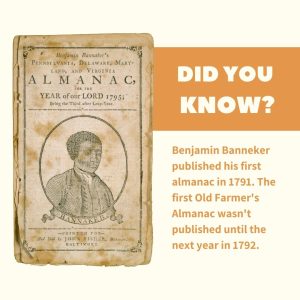Almanacs are annual publications that include a variety of information. In North America, almanacs such as The Old Farmer's Almanac, record and predict astronomical events (like the rising and setting of the Sun), tides, weather, and other phenomena with respect to time.
Benjamin Banneker published his almanacs annually from 1791-to 1797. His almanacs were innovative not only because they were produced by a black man in an age when African Americans were often considered incapable of scientific, mathematical, or literary accomplishment, but because they also included commentaries, literature, and other editorials that had a political and humanitarian purpose.
For example, in his 1793 edition, Banneker included his 1791 correspondence with Thomas Jefferson. In this correspondence, Banneker challenges Jefferson regarding the ideas he put forth in his "Notes on the State of Virginia" that implied African Americans were an inferior race. In the same volume, Banneker included excerpts from anti-slavery speeches and essays from England and America. Ultimately, these almanacs were not only useful publications providing important information, but they were also a form of advocacy for the abolition of slavery in the United States.
To learn more about the accomplishments and life of Benjamin Banneker, you can visit the Benjamin Banneker Historical Park and Museum. The museum (right here in the Patapsco Valley Heritage Area!) is located on the land where Banneker's homestead used to stand! You can learn more about the museum on their website.
Additionally, thanks to the efforts of the National Museum of African American History and Culture, you can take a look at the transcription of Banneker's 1793 almanac here.


